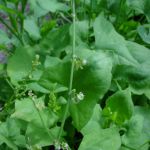| Common Name: |
Buckler-leaf Sorrel |
| Other Names: |
French Sorrel |
| Botanical Name: |
Rumex scutatus |
| Genus: |
Rumex |
| Family: |
Polygonaceae |
| Location: |
Europe, W Asia, and N Africa |
| Cultivation: |
Moist soil in sun or partial shade. Rumex crispus has deep roots and may be difficult to eradicate when established. It is subject to statuatory control as a weed in some countries, notably in parts of Australia. |
| Propagation: |
By seed sown in spring (species only); by division in autumn or spring. |
| Harvest: |
Leaves are picked when young and used fresh. Roots are lifted in autumn and dried for use in decoctions, liquid extracts, and tinctures. |
| Height: |
15-50cm (6-20in) |
| :Width |
1.2m (4ft) |
| Variations: |
Silver Shield
Has silver-green leaves. |
|
| Hardiness: |
Z4-8 |
| Parts Used: |
Leaves |
| Culinary Uses: |
Leaves are used in the same way as those of R. acetosa (See, Sorrel) but are more acidic. |
| Bibliography: |
Encylopedia of Herbs by Deni Brown Copyright ©: 1995, 2001 Dorling Kindersley Limited pp.351-352
|

